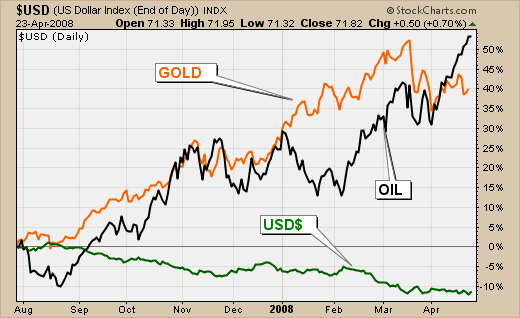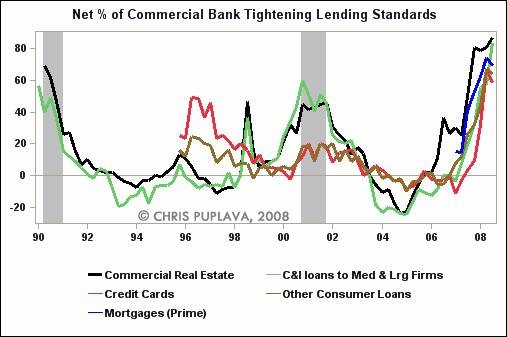Financial Sense Online Market Observation with Chris Puplava
Post on: 30 Апрель, 2015 No Comment

The absolute collapse in global financial markets post the Lehman bankruptcy and AIG bailout last year led to a selling panic that witnessed the Volatility Index (VIX) rise to record levels, peaking at 89.53 on October 24th of last year. Since then the level of fear has declined as investors perceive that the world is not going to fall off the proverbial cliff. As the peak in the VIX appears to have marked the peak in investor anxiety, the VIXs future direction will likely shed light to whether animal spirits return to the markets as investor risk appetites return. While the VIX proves useful in determining stock market trends, the analysis below shows that the VIXs utility extends to gauging several other financial and economic relationships. Looking at these relationships appears to be sending a collective message that the worst may indeed be over, with a complex bottoming process likely to ensue in the months ahead.
The September to October decline of 2008 witnessed the VIX rise roughly 371%, with the S&P 500 falling more than 30%. Since then the VIX has been in a declining trend and is currently sandwiched between its 50 day moving average (50d MA) above and its 200d MA from below. I can envision three possible scenarios with the VIXs future direction, and thus three possible stock market scenarios; the good, the bad, and the ugly. The ugly scenario would be if the VIX breaks out to the upside and exceeds its March and January highs, which we can then expect a significant sell off in the markets. However, if the VIX does break above its 50d MA but fails to breach its March and January highs, a likely trading range could ensue, with the markets also stuck in a trading, with the S&P 500 perhaps range bound with its November low of roughly 740, and resistance at 830-850, which would represent the bad scenario. The good scenario would be the VIX first breaking below its 200d MA and then showing a material break below the lower trend line support. Such an action in the VIX would likely be associated with a significant move in the markets with the S&P 500 likely breaking through 850 and staging an assault at its January high of 943.85. We should not have long to find out which scenario will play out as the two moving averages and trend lines are converging and a break in either direction is likely to be seen in the next few weeks.
Source: StockCharts.com
Economic Implications of the VIX
Part of the reason why the resolution to the VIXs future direction is so critical is the strong economic and financial correlations that exist with the VIX. For example, the average of the ISM Indexes (manufacturing and non-manufacturing) shows a strong inverse relationship with the VIX and a break down in the VIX should lead to an improvement in the ISM Index average. A break down in the VIX would indicate the rate of economic deceleration of the economy is moderating, the less bad hallmark of bottoms that I am keenly watching for. This VIX and ISM relationship can be seen below with the rate of change in the VIX inverted on the right axis, with the ISM average (blue) shown on the left axis. The peaking of the VIX (bottoming in chart) in 2002-2003 was associated with improvement in the ISM average as the low for the ISM average was seen in 2001 with a higher low in 2003. The strong deceleration in the VIX from 160%+ year-over-year (YOY) rate of change to under 80%+ is heralding a significant improvement in the ISM average, though it should be noted that any improvement in the near term for the ISM average is not likely to break above neutral ground (50), indicating the economy is still contracting, again, just at a less bad pace.
Any improvement in the ISM average would be a welcome sign and likely lead to improvement in the YOY rate of change in the S&P 500, as the two series show a strong correlation as seen in the figure below. The ISM Manufacturing Index came out today for March and showed a slight improvement over February. Two key improvements were in the New Orders Index as well as the Employment Index. The New Orders Index has a strong correlation with GDP exports and the Employment Index typically leads the YOY rate of change in nonfarm payrolls. As shown below in the second chart, the ISM Employment Composite (weighted by the share of manufacturing (15%) and non-manufacturing to total employment (85%)) typically leads the YOY rate of change in nonfarm payrolls, with the composite bottoming in 2001, several months prior to the rate of change trough in nonfarm payrolls. The recent spike in the composite could be heralding easier YOY employment comparisons in the months ahead and thus, more of the less bad I am looking for as signs of a bottom.
Source: ISM, Standard & Poors
Financial & Other Implications of the VIX
Another strong correlation that exists with the VIX index are corporate bond spreads. For example, the trend in Moodys BAA corporate and 10-Yr UST spread shows a close relationship with the VIX index, and the dramatic decline in the VIX after its October spike could be hinting that bond spreads may begin to decline. This in turn would mean that investment grade and high-yield bonds should begin to outperform US Treasuries, which appears to be the case when looking at the second figure below that shows the relative strength (RS) ratios of investment grade (LQD) and high-yield bond (HYG) ETFs relative to the 7-10yr US Treasury ETF (IEF).
Source: Bloomberg
Source: StockCharts.com
Another implication of an improvement in the VIX would be that we should start to see stocks outperform bonds. The VIX peaked in 2002 with the bond to stock ratio peaking several months later in 2003. We appear to be setting up a similar pattern where stocks may begin to outperform bonds as money moves away from the safety of US Treasuries and seeks higher returns in the stock market.
Source: Bloomberg
VIX & Risk Management Implications
One of the risk measures I developed over the last six months was based on the measure created by Bloomberg that was a stress index composite of the money market, bond market, and stock market. I made several modifications and also added stress indexes for the US Treasury market as well as currency markets so that my stress index reflected most major financial markets. One of the components of the equity stress index is the VIX, and I found that the VIX serves as a leading indicator to my overall stress index. The relationship between the two can be seen in the figure below with the VIX index shown inverted on the right axis. A further decline in the VIX would be hinting that my stress index would likely improve as the overall stress level in the financial markets begins to subside.
Source: Bloomberg
Ive been tinkering around over the last several months with several risk indicators and developed a portfolio trading system in which the portfolio allocates between the S&P 500 (SPY ) and US Treasuries based upon how many signals are on sells (allocate to bonds) and how many are on buys (allocate to stocks, S&P 500). Looking at how the model performed over the last 18 years showed how utilizing a risk management system can potentially improve market returns by avoiding the pain of being 100% invested in stocks through the duration of bear markets. The benefit of such a system can be seen below when comparing the portfolio values over time of $100K invested in the model, bonds only, and the S&P 500 only, with an initial investment in January of 1990.
What the model demonstrates is the importance of risk management in investment decisions. While the VIX may be signaling that the markets are bottoming, my four risk indicators are still on sell signals with the portfolio 100% in US Treasuries. Two of the indicators gave sell signals in 2007 while the other two gave sell signals in early 2008, progressively moving towards bonds over a six month period.
Risk Indicator Sell Signal Dates
- First Sell Signal: 09/07/2007
- Second Sell Signal: 11/09/2007
- Third Sell Signal: 01/11/2008
- Fourth Sell Signal: 02/22/2008

With the S&P 500 simply tracing out a complex bottom by staying within a trading range of the 2009 low (666) and high (943), the negative momentum in the S&P 500 will begin to wear off and the indicators will progressively move to buy signals, moving funds out of bonds and into stocks.
Looking at other relationships hints that the bottom in the markets is developing. As highlighted last week, the Euro/Yen cross rate broke out of its trading range and so far is displaying a successful retest. If the cross rate breaks below 1.30 materially the current breakout will be whipsaw, which should be monitored as it is a good risk proxy and may provide hints to the markets direction.
Source: StockCharts.com
Another chart I presented last week looked at relative strength ratios of some key cyclicals such as retail, housing, and consumer discretionary. If the VIX breaks its log trend and is accompanied by trend line breaks in the RS ratios of retail, housing, and consumer discretionary sector, then there is a very good chance that the worst is over with a possible sizable rally in the markets.
Source: StockCharts.com
In the short-term I think the market needs to consolidate and I am a bit concerned about the high degree of bullishness exhibited in the options market with the CBOE total options put/call ratio at the lowest level in years, a negative contrary indicator. There is also slowing in the NYSE Summation Index which could be heralding a possible turn in the markets.
Source: StockCharts.com
Source: StockCharts.com
These two developments have me on a wait-and-see approach, though the action in the VIX so far is quite encouraging. Its too soon to tell whether or not the VIX will break to the upside or the downside, but the resolution will be a key indicator as it tends to move inversely with the stock market. Thus, for the time being I have my eyes fixed on the VIX.
Chris Puplava
2009 Chris Puplava














